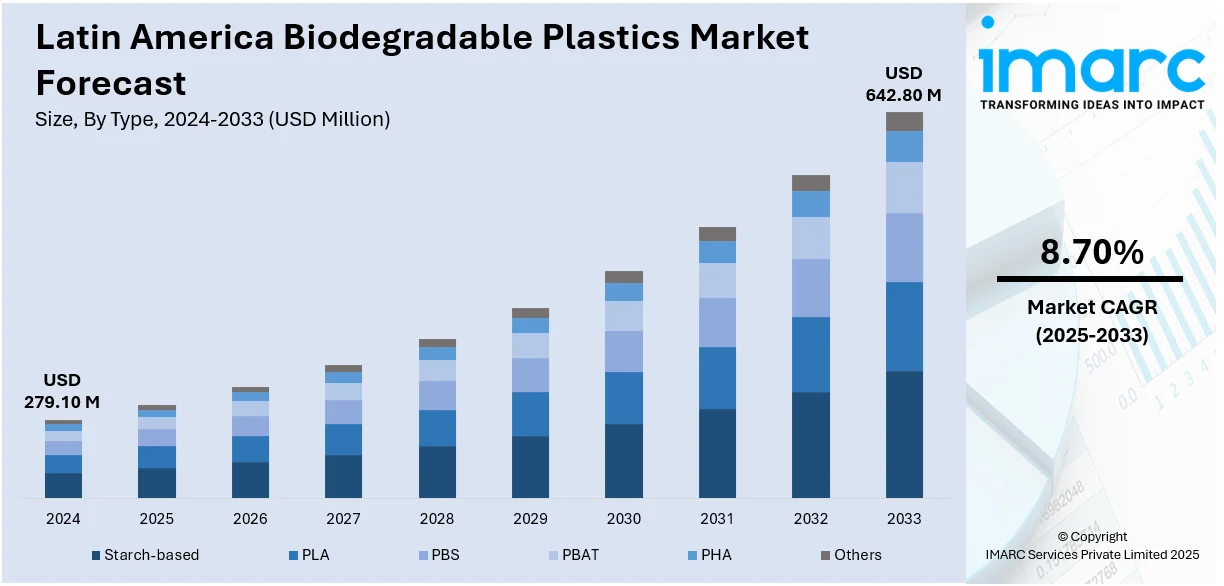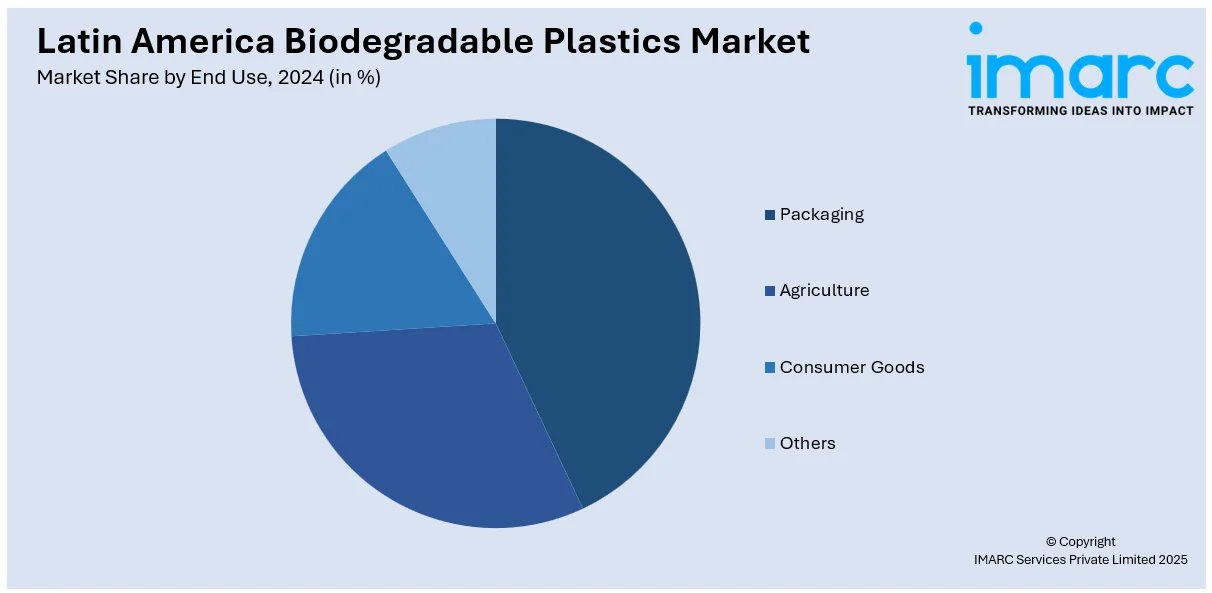
Latin America Biodegradable Plastics Market Size, Share, Trends and Forecast by Type, End Use, and Region, 2025-2033
Latin America Biodegradable Plastics Market Overview:
The Latin America biodegradable plastics market size reached USD 279.10 Million in 2024. Looking forward, IMARC Group expects the market to reach USD 642.80 Million by 2033, exhibiting a growth rate (CAGR) of 8.70% during 2025-2033. Rising environmental awareness, increasing government regulations on plastic waste and growing demand for sustainable packaging solutions are driving the Latin America biodegradable plastics market share. Besides this, advancements in biopolymer technologies and increasing consumer preference for eco-friendly products in everyday use is strengthening the market growth.
|
Report Attribute
|
Key Statistics
|
|---|---|
|
Base Year
|
2024 |
|
Forecast Years
|
2025-2033
|
|
Historical Years
|
2019-2024
|
| Market Size in 2024 | USD 279.10 Million |
| Market Forecast in 2033 | USD 642.80 Million |
| Market Growth Rate 2025-2033 | 8.70% |
Latin America Biodegradable Plastics Market Trends:
Growing Demand for Sustainable Packaging Solutions
One of the major trends impelling the Latin America biodegradable plastics market growth is the rising need for eco-friendly packaging solutions. With people and companies becoming increasingly conscious about the environmental effects of traditional plastics, there is a surge toward packaging that reduces waste and minimizes carbon footprints. Bioplastics, made from renewable sources such as corn starch, sugarcane, and cellulose, are picking up as a good replacement for conventional plastic packaging. In the food and beverage (F&B) sector there is an increased preference for biodegradable packaging material, which has durability and functionality levels on par with traditional plastics. There is an increased application of biodegradable plastics in packaging and wrapping food packs, utensils, bags, and wraps by Latin American firms because of a shift in government regulations. Some other drivers for growth are e-commerce and increased demand for sustainable packaging. The region is investing in sustainability, due to the rising demand for biodegradable plastics in packaging, making Latin America a hotbed for this worldwide green packaging trend.

Rising Government Regulations on Plastic Waste
Government regulations to combat plastic waste is a major trend that is defining the Latin America biodegradable plastics market outlook. Some countries in the region are launching tough regulations and single-use plastic bags, which will encourage the adoption of biodegradable options. According to the United Nations Environment Programme (UNEP), the National Plan for sustainable single-use plastics management targets to ensure 100 per cent of single-use plastics that enter the market are reusable, recyclable, or compostable by 2030. Governing agencies are looking at ways of mitigating plastic waste pollution, especially along coastlines and urban spaces, where plastic debris aggregation causes severe environmental challenges. Responding to this, industries are being encouraged to incorporate biodegradable plastics into their products to become compliant and to prevent punishment. These legal directives have actually contributed to creativity in the manufacturing of biodegradable plastic materials with businesses attempting to conform to emerging regulatory paradigms. Laws prohibiting the use of plastic bags and other one-time-only goods in hospitality and retail markets are, for instance, catalyzing movement to biodegradable alternatives. This trend is propelling the market growth for biodegradable plastics and encouraging more research and development (R&D) to develop cheaper, more efficient, and accessible biodegradable products. As government policies become increasingly stringent throughout Latin America, the biodegradable plastics market is likely to grow at a very fast pace.
Advancements in Biopolymer Technologies
Innovations in producing biopolymers such as polyhydroxyalkanoates (PHA), polylactic acid (PLA), and starch-based polymers, allow increasing the performance characteristics of biodegradable plastics. These bioplastics have properties of enhanced toughness and flexibility as well as biodegradability. They are thus suitable for almost every application in packaging, agricultural, textile, and medicament productions. The further research and development are in the effort to make bioplastics as cost competitive as possible with traditional plastics so that their adoption is made broader across various industries. This helps integrate biotechnology and nanotechnology with production processes for developing biopolymers, such as plastics that are biodegradable. They offer enhanced strength, heat resistance, and fast degradation compared to the traditional plastic materials. Investment in production facilities is also contributing to this trend and speeding the increase and availability of biodegradable plastics at affordable prices. Increased demand for the adoption of superior and efficient bioplastics will generate more investments, and this is being further complemented by the gradual increase in the use of biodegradable plastics in Latin America, which will unlock more opportunities for entrepreneurs in the region to benefit from this emerging market for sustainable materials.
Latin America Biodegradable Plastics Market Segmentation:
IMARC Group provides an analysis of the key trends in each segment of the market, along with forecasts at the country level for 2025-2033. Our report has categorized the market based on type and end use.
Type Insights:
- Starch-based
- PLA
- PBS
- PBAT
- PHA
- Others
The report has provided a detailed breakup and analysis of the market based on the type. This includes starch-based, PLA, PBS, PBAT, PHA, and others.
End Use Insights:

- Packaging
- Agriculture
- Consumer Goods
- Others
A detailed breakup and analysis of the market based on the end use have also been provided in the report. This includes packaging, agriculture, consumer goods, and others.
Regional Insights:
- Brazil
- Mexico
- Argentina
- Colombia
- Chile
- Peru
- Others
The report has also provided a comprehensive analysis of all the major regional markets, which include Brazil, Mexico, Argentina, Colombia, Chile, Peru, and others.
Competitive Landscape:
The market research report has also provided a comprehensive analysis of the competitive landscape. Competitive analysis such as market structure, key player positioning, top winning strategies, competitive dashboard, and company evaluation quadrant has been covered in the report. Also, detailed profiles of all major companies have been provided.
Latin America Biodegradable Plastics Market News:
- In January 2024, American Airlines Cargo reduced plastic waste by over 150,000 lbs, equivalent to 8.6 million water bottles, through its partnership with BioNatur Plastics. This innovative material replaces stretch wrap and pallet covers, featuring a food-safe additive that enables landfill decomposition. The airline has implemented it at domestic hubs like DTW, HNL, MSP, and internationally at MVD and SCL in Latin America.
- On May 23, 2023, Circulate Capital, a prominent environmental impact investor promoting the circular economy for plastics in rapidly expanding markets, unveiled a new initiative aimed at addressing plastic pollution in Latin America and the Caribbean (LAC).
Latin America Biodegradable Plastics Market Report Coverage:
| Report Features | Details |
|---|---|
| Base Year of the Analysis | 2024 |
| Historical Period | 2019-2024 |
| Forecast Period | 2025-2033 |
| Units | Million USD |
| Scope of the Report |
Exploration of Historical Trends and Market Outlook, Industry Catalysts and Challenges, Segment-Wise Historical and Future Market Assessment:
|
| Types Covered | Starch-based, PLA, PBS, PBAT, PHA, Others |
| End Uses Covered | Packaging, Agriculture, Consumer Goods, Others |
| Regions Covered | Brazil, Mexico, Argentina, Colombia, Chile, Peru, Others |
| Customization Scope | 10% Free Customization |
| Post-Sale Analyst Support | 10-12 Weeks |
| Delivery Format | PDF and Excel through Email (We can also provide the editable version of the report in PPT/Word format on special request) |
Key Questions Answered in This Report:
- How has the Latin America biodegradable plastics market performed so far and how will it perform in the coming years?
- What is the breakup of the Latin America biodegradable plastics market on the basis of type?
- What is the breakup of the Latin America biodegradable plastics market on the basis of end use?
- What are the various stages in the value chain of the Latin America biodegradable plastics market?
- What are the key driving factors and challenges in the Latin America biodegradable plastics market?
- What is the structure of the Latin America biodegradable plastics market and who are the key players?
- What is the degree of competition in the Latin America biodegradable plastics market?
Key Benefits for Stakeholders:
- IMARC’s industry report offers a comprehensive quantitative analysis of various market segments, historical and current market trends, market forecasts, and dynamics of the Latin America biodegradable plastics market from 2019-2033.
- The research report provides the latest information on the market drivers, challenges, and opportunities in the Latin America biodegradable plastics market.
- Porter's five forces analysis assist stakeholders in assessing the impact of new entrants, competitive rivalry, supplier power, buyer power, and the threat of substitution. It helps stakeholders to analyze the level of competition within the Latin America biodegradable plastics industry and its attractiveness.
- Competitive landscape allows stakeholders to understand their competitive environment and provides an insight into the current positions of key players in the market.
Need more help?
- Speak to our experienced analysts for insights on the current market scenarios.
- Include additional segments and countries to customize the report as per your requirement.
- Gain an unparalleled competitive advantage in your domain by understanding how to utilize the report and positively impacting your operations and revenue.
- For further assistance, please connect with our analysts.
 Inquire Before Buying
Inquire Before Buying
 Speak to an Analyst
Speak to an Analyst
 Request Brochure
Request Brochure
 Request Customization
Request Customization




.webp)




.webp)












